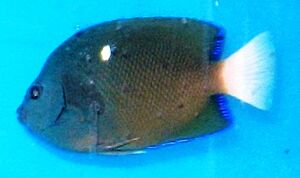Clipperton angelfish facts for kids
Quick facts for kids Clipperton angelfish |
|
|---|---|
 |
|
| Conservation status | |
| Scientific classification |
The Clipperton angelfish (Holacanthus limbaughi) is a beautiful fish that lives in the ocean. It's a type of marine angelfish and belongs to the Pomacanthidae family. This special fish is only found around Clipperton Island. This island is a French territory in the eastern Pacific Ocean.
Contents
What Does the Clipperton Angelfish Look Like?
The Clipperton angelfish has a body that is tall and flat from side to side. It has a small mouth with teeth that look like bristles.
Young vs. Adult Angelfish
Young Clipperton angelfish are dark bluish-grey. They have several bright blue stripes on their bodies. Two stripes are on their head, and five are on their sides. They also have a white spot near the top of their body. Their tail fin and side fins are white.
As they grow older, these stripes fade away. Adult angelfish are similar, but they don't have the stripes. Their top fin, bottom fin, and belly fins have bright blue edges.
Size of the Angelfish
This fish can grow up to 30 centimetres (12 in) long. That's about the length of a standard ruler!
Where Does the Clipperton Angelfish Live?
The Clipperton angelfish is only found near Clipperton Island. This island is a French territory located in the Eastern Pacific Ocean. It is about 2,560 kilometres (1,590 mi) west of Costa Rica.
Clipperton Angelfish Habitat and Life
This angelfish lives in the ocean at depths between 6 and 100 metres (20 and 328 ft). Scientists don't know much about where it prefers to live or how it behaves. More research is needed to understand this unique fish better.
Naming the Clipperton Angelfish
The Clipperton angelfish was first officially described in 1963. An American fish expert named Wayne J. Baldwin gave it its scientific name. The second part of its name, limbaughi, honors Conrad Limbaugh. He was an American diver and zoologist. He helped collect the very first fish specimen used to describe the species.
Why is This Angelfish Special?
The Clipperton angelfish is very rare. It lives in a remote area, so it's hard to find. Because it's so rare, it is not often seen in fish tanks. When it does appear, it can be very expensive.
Protecting the Angelfish
Because of its rarity and value, some people have tried to collect these fish without permission. It's important to protect rare species like the Clipperton angelfish. This helps keep them safe in their natural home.


